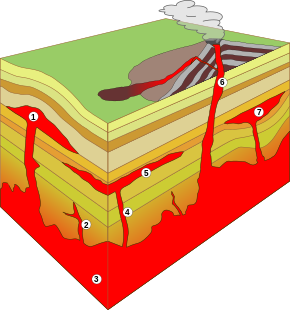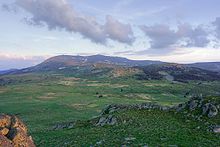Batholith

A batholith (from

1. Laccolith
2. Small dike
3. Batholith
4. Dike
5. Sill
6. Volcanic neck and pipe
7. Lopolith
Note: As a general rule, in contrast to the active volcanic vent in the figure, these names refer to the fully cooled and usually millions-of-years-old rock formations, which are the result of the underground magmatic activity shown.
Formation
Although they may appear uniform, batholiths are in fact structures with complex histories and compositions. They are composed of multiple masses, or

Traditionally, these plutons have been considered to form by ascent of relatively buoyant magma in large masses called plutonic diapirs. Because the diapirs are liquified and very hot, they tend to rise through the surrounding native country rock, pushing it aside and partially melting it. Most diapirs do not reach the surface to form volcanoes, but instead they slow down, cool, and usually solidify 5 to 30 kilometers underground as plutons (hence the use of the word pluton; in reference to the Roman god of the underworld Pluto). An alternate view is that plutons are formed by aggregation of smaller volumes of magma that ascend as dikes.[2]
A batholith is formed when many plutons converge to form a huge expanse of granitic rock. Some batholiths are mammoth, paralleling past and present
Surface expression and erosion
A batholith is an exposed area of (mostly) continuous plutonic rock that covers an area larger than 100 square kilometers (40 square miles). Areas smaller than 100 square kilometers are called stocks.[3] However, the majority of batholiths visible at the surface (via outcroppings) have areas far greater than 100 square kilometers. These areas are exposed to the surface through the process of erosion accelerated by continental uplift acting over many tens of millions to hundreds of millions of years. This process has removed several tens of square kilometers of overlying rock in many areas, exposing the once deeply buried batholiths.
Batholiths exposed at the surface are subjected to huge pressure differences between their former location deep in the earth and their new location at or near the surface. As a result, their crystal structure expands slightly over time. This manifests itself by a form of mass wasting called exfoliation. This form of weathering causes convex and relatively thin sheets of rock to slough off the exposed surfaces of batholiths (a process accelerated by frost wedging). The result is fairly clean and rounded rock faces. A well-known result of this process is Half Dome in Yosemite Valley.
Examples
Africa
Antarctica
Asia
Europe
|
North America
Oceania
South America
|
See also
References
- ISBN 978-1-305-65264-4.
- ISBN 9780520249325.
- ^ GLENCOE SCIENCE | Earth Science Twelfth Grade High School Textbook (Georgia); pg. 115 paragraph 1, pg. 521 question 9
- doi:10.1093/petrology/egq014.)
{{cite journal}}: CS1 maint: multiple names: authors list (link - ^ "Bhongir fort's batholith marvel". June 2016.
- ^ "Rapid Uplift: Mount Abu Geology". 22 July 2018.
- ^ Erik H. Erikson Jr. "Petrogenesis of the Mount Stuart Batholith Plutonic Equivalent of the High-Aluina Basalt Association" (PDF).
The Mount Stuart batholith is a Late Cretaceous calc-alkaline pluton composed of intrusive phases ranging in composition from two-pyroxene gabbro to granite.
- ^ Myrl E. BeckJr.; Russell F. Burmester; Ruth Schoonover. "Paleomagnetism and tectonics of the Cretaceous Mt. Stuart Batholith of Washington: translation or tilt?".
The Mt. Stuart Batholith is a composite pluton of Late Cretaceous age that intrudes the crystalline North Cascades terrane of northwestern Washington.
- ISBN 9780813712116.
- S2CID 131845599. Retrieved June 8, 2016.
...Neoarchean granite batholith, herein named the Wyoming batholith, extends more than 200 km across central Wyoming in the Granite and the Laramie Mountains.
- ^ Stratigraphic revision and remapping of the Mathinna Supergroup between the River Tamar and the Scottsdale Batholith, northeast Tasmania, Department of Infrastructure, Energy and Resources. Mineral Resources Tasmania. June 2011
- Plummer, McGeary, Carlson, Physical Geology, Eighth Edition (McGraw-Hill: Boston, 1999) pages 61–63 ISBN 0-697-37404-1
- Glazner, Bartley, Coleman, Gray, Taylor, Are plutons assembled over millions of years by amalgamation from small magma chambers?, GSA Today: Vol. 14, No. 4, pp. 4–11
